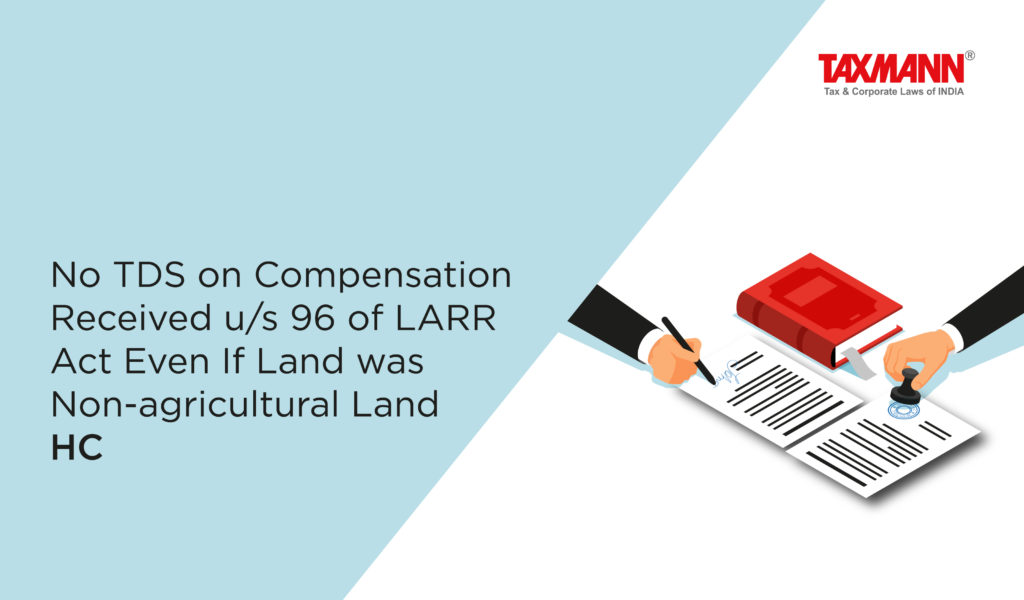No TDS on Compensation Received u/s 96 of LARR Act Even If Land was Non-agricultural Land | HC
- Blog|News|Income Tax|
- 2 Min Read
- By Taxmann
- |
- Last Updated on 18 September, 2023

Case Details: Sharanappa v. Deputy Commissioner - [2023] 153 taxmann.com 685 (Karnataka)
Judiciary and Counsel Details
-
- Suraj Govindaraj, J.
- Mahantesh Patil, Adv. for the Petitioner.
- Shivakumar R. Tengli, AGA for the Respondent.
Facts of the Case
Assessee’s land was acquired under the Right to Fair Compensation and Transparency in Land Acquisition, Rehabilitation and Resettlement Act, 2013 (LARR Act). Compensation, along with interest, was fixed with respect to such acquisition. Subsequently, the Principal District and Sessions Judge directed withholding of 30% of the amount on the accrued interest in accordance with section 194LA.
Aggrieved by the order, the assessee filed a writ petition to the Karnataka High Court.
High Court Held
The Court held that section 194LA requires any person responsible for paying to the resident any sum being in the nature of compensation or enhanced compensation, or consideration or enhanced consideration on account of compulsory acquisition of immovable property other than agricultural land at the time of payment of such sum, has to deduct an amount equivalent to 10% as income tax.
Further, the second proviso to section 194LA clearly makes out an exemption from the levy of income tax in cases when the land has been acquired, and compensation is covered under section 96 of the LARR Act. The proviso does not make any difference between agricultural or non-agricultural land.
Section 96 of the Act of 2013 makes it abundantly clear that no income tax or stamp duty shall be levied on any award or agreement made under the Act except under section 46, which relates to the purchase of land through private negotiations, which necessarily means otherwise than through acquisition.
Thus, any land acquired and compensation paid as per section 96 of the LARR Act would not attract any income tax. When the compensation itself is exempted from income tax, the question of deducting tax at source on such exempted income would also not arise. Hence, as long as the award is made under the LARR Act, the compensation paid would not be liable for any tax.
Disclaimer: The content/information published on the website is only for general information of the user and shall not be construed as legal advice. While the Taxmann has exercised reasonable efforts to ensure the veracity of information/content published, Taxmann shall be under no liability in any manner whatsoever for incorrect information, if any.

Taxmann Publications has a dedicated in-house Research & Editorial Team. This team consists of a team of Chartered Accountants, Company Secretaries, and Lawyers. This team works under the guidance and supervision of editor-in-chief Mr Rakesh Bhargava.
The Research and Editorial Team is responsible for developing reliable and accurate content for the readers. The team follows the six-sigma approach to achieve the benchmark of zero error in its publications and research platforms. The team ensures that the following publication guidelines are thoroughly followed while developing the content:
- The statutory material is obtained only from the authorized and reliable sources
- All the latest developments in the judicial and legislative fields are covered
- Prepare the analytical write-ups on current, controversial, and important issues to help the readers to understand the concept and its implications
- Every content published by Taxmann is complete, accurate and lucid
- All evidence-based statements are supported with proper reference to Section, Circular No., Notification No. or citations
- The golden rules of grammar, style and consistency are thoroughly followed
- Font and size that’s easy to read and remain consistent across all imprint and digital publications are applied



 CA | CS | CMA
CA | CS | CMA
